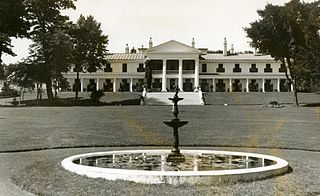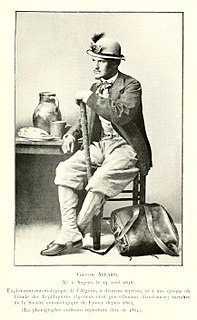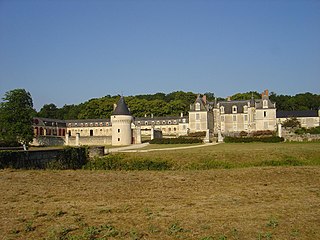
The Parc Oriental de Maulévrier (29 hectares) is a Japanese garden located in Maulévrier, Maine-et-Loire, Pays de la Loire, France. It is open daily except Monday in the warmer months; an admission fee is charged.

Japanese gardens are traditional gardens whose designs are accompanied by Japanese aesthetic and philosophical ideas, avoid artificial ornamentation, and highlight the natural landscape. Plants and worn, aged materials are generally used by Japanese garden designers to suggest an ancient and faraway natural landscape, and to express the fragility of existence as well as time's unstoppable advance.

Maulévrier is a commune in the Maine-et-Loire department in western France.

Maine-et-Loire is a department of the Loire Valley in west-central France, in the Pays de la Loire region.
The park was created between 1899-1913 on the grounds of Château Colbert by noted Parisian architect Alexandre Marcel (1860-1928), designer of the Cambodia pavilion at the Exposition Universelle (1900), for the château's industrialist owner. Indeed, the park's Khmer elements are reproduced from molds from the exhibition. Having married the owner's daughter, Marcel often dwelt in the château as he oversaw its landscaping. After his death, she remained in residence until her own death in 1945, after which time the park fell into desolation for 40 years.

Alexandre Marcel was a French architect, best known for his Belle Époque interpretations of "exotic" international architectural styles.

Cambodia, officially the Kingdom of Cambodia, is a country located in the southern portion of the Indochina peninsula in Southeast Asia. It is 181,035 square kilometres in area, bordered by Thailand to the northwest, Laos to the northeast, Vietnam to the east and the Gulf of Thailand to the southwest.

The Exposition Universelle of 1900, better known in English as the 1900 Paris Exposition, was a world's fair held in Paris, France, from 14 April to 12 November 1900, to celebrate the achievements of the past century and to accelerate development into the next. The style that was universally present in the Exposition was Art Nouveau. The fair, visited by nearly 50 million, displayed many machines, inventions, and architecture that are now nearly universally known, including the Grande Roue de Paris Ferris wheel, Russian nesting dolls, diesel engines, talking films, escalators, and the telegraphone.
In 1976 the château's property was cut in three, with the municipality purchasing the park's segment in 1980. Restoration began in 1987, based upon photographs and memories, and by 2004 the garden was named a "Jardin Remarquable" by the ministry of culture.
Today the park is the largest Japanese garden in France. It contains about 300 plant species, with water features, a bridge, and a pagoda, as well as azaleas, camellias, rhododendrons, and Japanese maples. There is also a permanent exhibition of bonsai and ceramics.
In biology, a species ( ) is the basic unit of classification and a taxonomic rank of an organism, as well as a unit of biodiversity. A species is often defined as the largest group of organisms in which any two individuals of the appropriate sexes or mating types can produce fertile offspring, typically by sexual reproduction. Other ways of defining species include their karyotype, DNA sequence, morphology, behaviour or ecological niche. In addition, paleontologists use the concept of the chronospecies since fossil reproduction cannot be examined. While these definitions may seem adequate, when looked at more closely they represent problematic species concepts. For example, the boundaries between closely related species become unclear with hybridisation, in a species complex of hundreds of similar microspecies, and in a ring species. Also, among organisms that reproduce only asexually, the concept of a reproductive species breaks down, and each clone is potentially a microspecies.

A pagoda is a tiered tower with multiple eaves, built in traditions originating as stupa in historic South Asia and further developed in East Asia with respect to those traditions, common to Nepal, China, Japan, Korea, Vietnam, Myanmar, India, Sri Lanka and other parts of Asia. Some pagodas are used as Taoist houses of worship. Most pagodas were built to have a religious function, most commonly Buddhist, and were often located in or near viharas. In some countries, the term may refer to other religious structures. In Vietnam and Cambodia, due to French translation, the English term pagoda is a more generic term referring to a place of worship, although pagoda is not an accurate word to describe a Buddhist vihara. The modern pagoda is an evolution of the stupa which originated in ancient India. Stupas are a tomb-like structure where sacred relics could be kept safe and venerated. The architectural structure of the stupa has spread across Asia, taking on many diverse forms as details specific to different regions are incorporated into the overall design. Many Philippine bell towers are highly influenced by pagodas through Chinese workers hired by the Spaniards.

Azaleas are flowering shrubs in the genus Rhododendron, particularly the former sections Tsutsuji (evergreen) and Pentanthera (deciduous). Azaleas bloom in the spring, their flowers often lasting several weeks. Shade tolerant, they prefer living near or under trees. They are part of the family Ericaceae.











